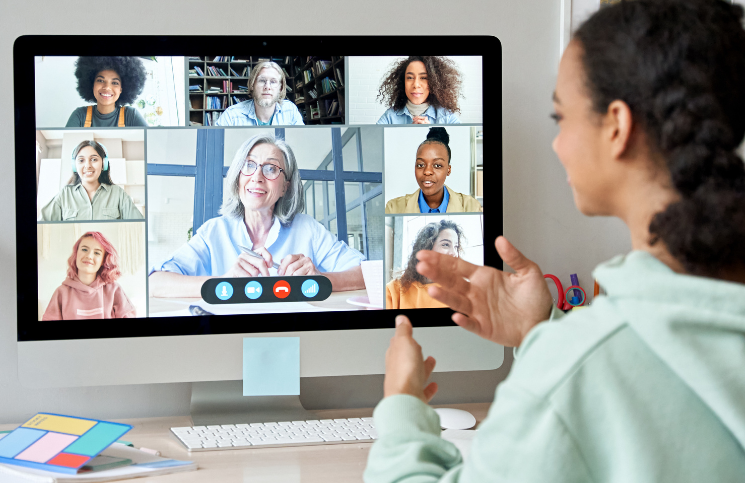JFYNet Learning Specialists reflect on their experiences during the Covid 19 shutdown
Greg Cunningham
The first half of this academic year has been fraught with challenges for both teachers and students. They had to adjust to remote learning, then shift to hybrid learning, only to revert to full remote as the Coronavirus numbers surged in many communities. Math teachers at Madison Park High School are adding lessons and conducting live instruction online using JFYNet software to supplement their lessons. Students in the Bridgewater State University dual enrollment course in Public Speaking at Durfee High School in Fall River have been successfully attending synchronous instruction online with BSU professors. The students have thrived using the online format, even speaking and presenting via their computer cameras. A high point in remote learning has certainly been achieved by Kingsman Academy Public Charter School in Washington, DC, whose students have logged hundreds of hours of academic work using JFYNet software as their primary learning platform. All these students will be well prepared when schools are allowed to welcome them back into the traditional platform, the classroom, to continue their academic careers. Expectations are that their laptops will come with them and teachers will combine the online methods and materials they have mastered with traditional in-person teaching—the best of both worlds.
Cathie Maglio
In the six years I have been working at JFYNetWorks, this is the first time I have not set foot in a school during the first week of classes! Even though I am not physically in the school, my work with teachers continues. I am setting up classes in our math and ELA software. I am training new teachers on the software via Zoom. I am running performance reports to keep teachers informed on how their students are doing. I have even attended classes via Zoom. I am interacting constantly with my teachers via email and Zoom. The content of my work has not really changed. What has changed is the connection I feel with teachers and students. I am looking forward to the day when I can walk into East Boston High again and hand out Christmas cookies to the door monitor, the ladies in the office, the headmaster, the assistant headmaster, the librarian, and the students and teachers. A school is a social organism. You can’t smell the cookies over Zoom.
Eileen Wedegartner
The proverbial luck of the Irish was not with the Commonwealth, or the nation for that matter, on St. Patrick’s Day, March 17, the day the schools shut down. Through the rest of that remote spring, a feeling of helplessness took hold both personally and professionally as I navigated a complete shift in how I work with and reach students. But as summer came and went, I had time to think about ways to use our programs and instructional model to engage with students in the new online environment. Having taken time to learn about promising practices for remote education while also having access to a large network of innovative teachers, I felt significantly more hopeful about the potential for remote learning. There have been spells of frustration, failure and exhaustion, but I have been deeply impressed by schools’ tenacity and teachers’ dedication to serving students. Most of all, I have been heartened by children’s resilience as they adapt to the changing demands of this challenging time.
The dual enrollment program with Bridgewater State and Durfee High was the biggest shift for me, having no direct contact at all with students. However, the remote format allowed me to coach students individually in shorter but more frequent sessions and sharpen their specific skills where needed. On top of this, meeting one to one with teachers via Zoom to do training and answer questions has allowed us to go more in-depth because we meet without the constraints of travel time and the rigid school schedule with its attention-shattering bells. These are practices that can continue and become part of how we give support, making it more accessible. I am optimistic that our adjustments and spontaneous innovations during this unique period will prepare us for future events and help us better engage students through the techniques we have developed. We are all eager to return to normal and see students and colleagues face to face. Yet the enforced remoteness has pushed us to develop new ways to reach and engage students who struggle in the traditional learning environment. We will certainly bring those tools and strategies back into the classroom, making it more equitable for all.
Joan Reissman
When the world shut down last March, I doubt anyone imagined how quickly technology would become an integral part of instruction. Teachers needed online curriculum right away, with no lead time. Teachers who were working with JFYNet already had online curriculum. And they had training and support. Our students were better prepared to make the shift because they had been spending part of their school day online with our program before the shutdown. I see articles in the media every day about the failures of remote learning, but I know that remote learning can work. I see it in our schools. I am happy that I can play a part in helping teachers and students continue learning despite the disruption of the learning environment. I support them by developing resource guides, writing webinars and designing curriculum. I have been most involved with Kingsman Academy and I marvel at the dedication and hard work of the students and teachers. One student at Kingsman has completed more than 80 math tasks in just a few weeks—an incredible achievement. Like all my colleagues, I look forward to returning to normal, but I am gratified to play a role in supporting teachers and students during this critical time.





